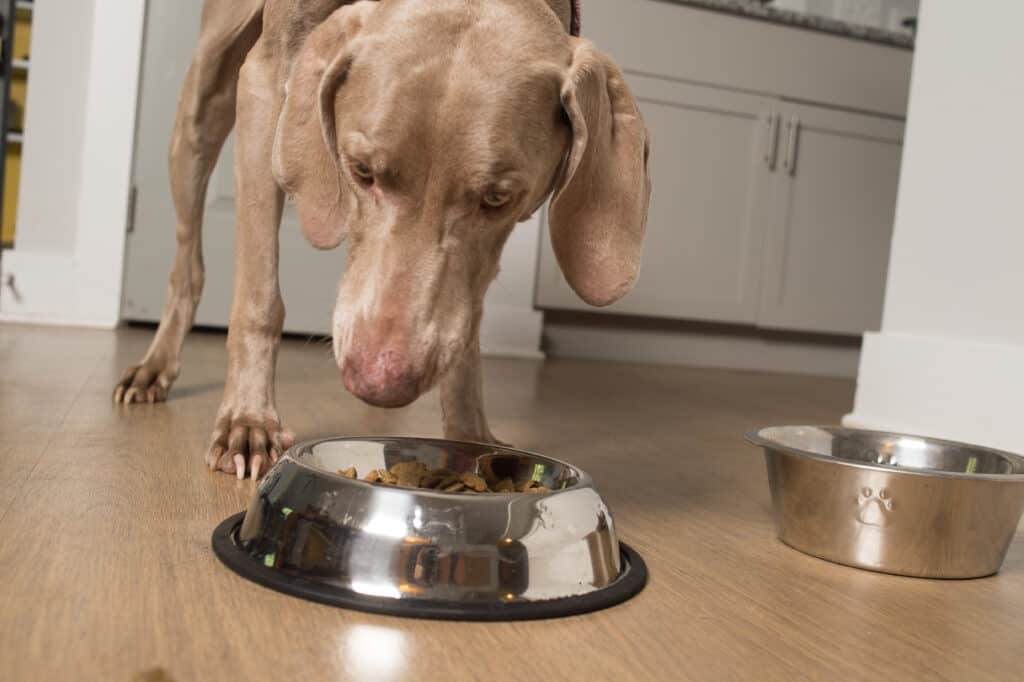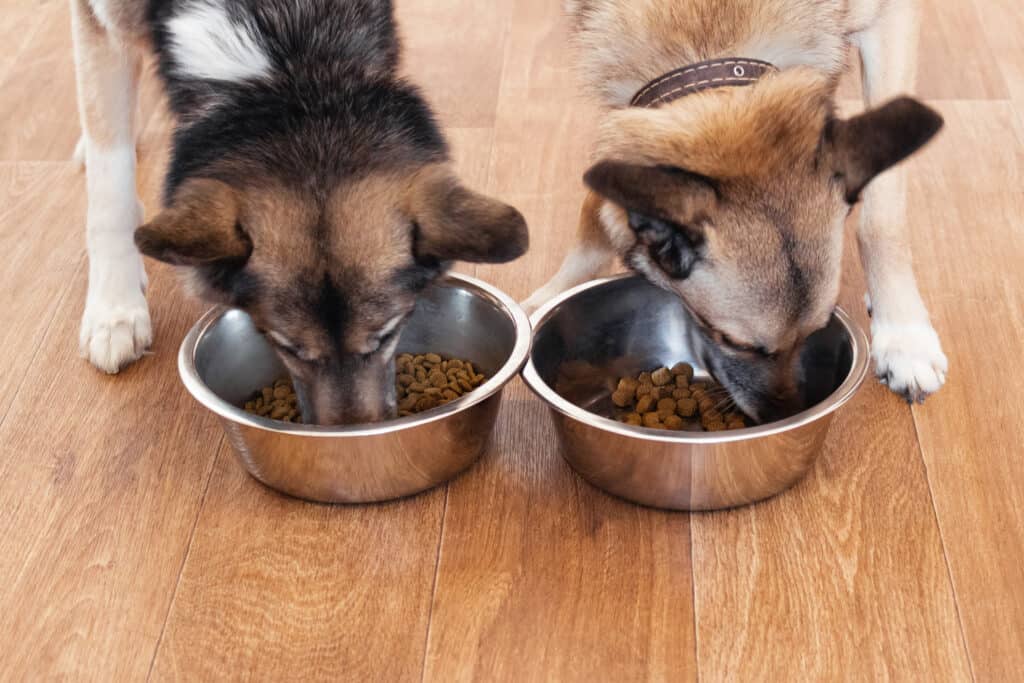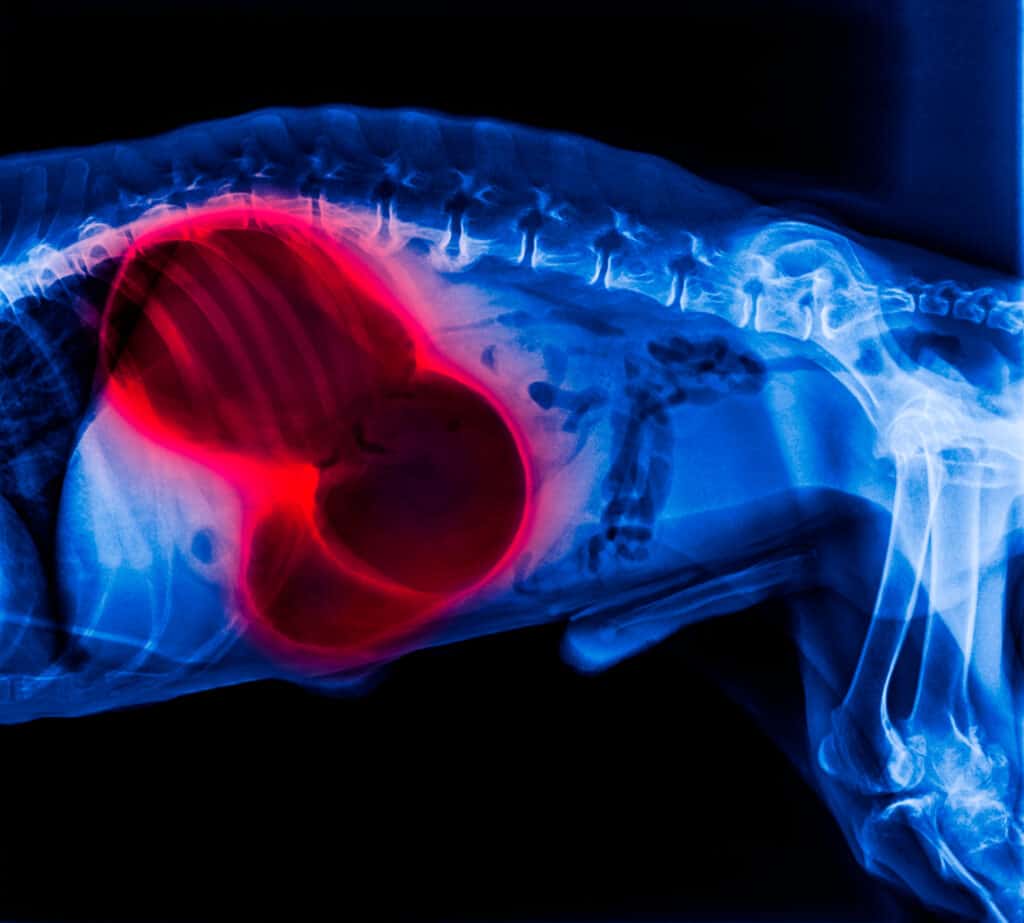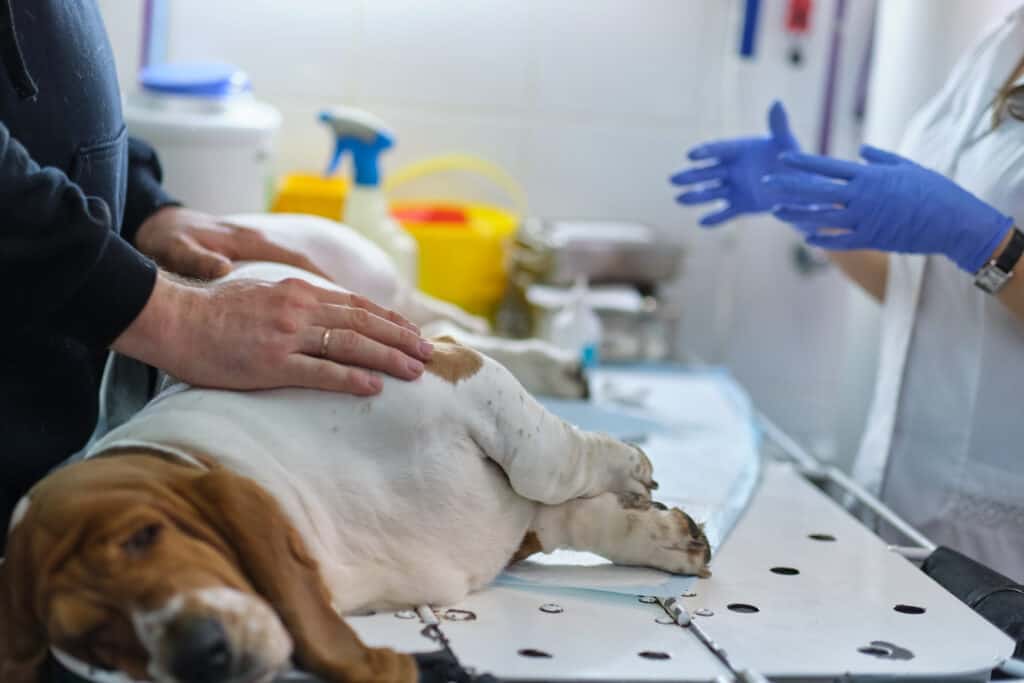When we hear the word “bloat” passed around, many of us will think of consuming a delicious meal until our stomachs are filled to the brim. Some meals are so tasty that we eat to the point of being uncomfortably full, and this same thing can happen to our canine friends as well! Many dogs cannot stop themselves when they have access to a large amount of food, with some dogs even eating to the point of making themselves sick.
While being stuffed from a large meal is just an uncomfortable feeling for humans, a stomach packed with food can be extremely dangerous for the dogs in our life. Bloat in dogs can occur when their stomach fills with either too much food or too much air, and it can even progress to a life threatening condition in which the stomach flips on itself.
Due to how serious of a condition bloat is in dogs, we want you to be aware of all the details of this canine emergency. We will discuss the possible causes of bloat in dogs, the signs and symptoms you should be on the lookout for, and the treatment options that are available to your pup in these situations.
Let’s get started!
What is Bloat in Dogs?
Many pet parents have heard of the dreaded canine medical complication known as bloat. There are many rumors circulating about this life-threatening condition, especially in regards to what causes it. We want you to be as informed as possible when it comes to the different types of bloat in dogs, seeing as there are many misconceptions surrounding the condition.
Bloat in dogs occurs when either food, liquid, or gas becomes trapped inside of the dog’s stomach. This can cause the dog’s stomach to expand rapidly within the abdomen, which at the least leads to uncomfortable bloating. Not only can this be uncomfortable for the dog affected, but it can progress into a serious medical situation. Dogs with bloat can experience severe abdominal pain, difficulty breathing due to pressure on the lungs, blood circulation complications due to the pressure on the surrounding veins, and even the potential for the stomach to flip on itself causing a gastric dilatation volvulus (GDV).
The term bloat in dogs is often used interchangeably among pet parents when discussing the different levels of complication. To make sure you understand the different forms of bloat in dogs and the level of threat they possess, let’s break down each type of bloat in dogs below.

Statistically speaking dogs with large, deep chests are more prone to GDV though all dogs are at risk.
©Laura Beach/Shutterstock.com
Breaking Down the Types of Bloat in Dogs
As we mentioned above, the term bloat is often used across the board to describe any situation in which food, air, or liquid is trapped inside of a dog’s stomach. To make sure you understand the situation your dog is experiencing, let’s describe each form of bloat in dogs below.
Food Bloat
Food bloat refers to a scenario in which your dog consumed a large amount of food very quickly. This often occurs when a dog gains access to a full bag of kibble, causing them to eat and eat to the point of extreme fullness. Eating such a large amount of food all at once will cause the stomach to fill with the food material, and it will be challenging for the digestive process to keep up.
The food-filled stomach will expand and become very uncomfortable, and the dog will only find relief once they can vomit up the food or slowly pass it along their digestive tract. Dogs with food bloat will often have distended and painful abdomens, they might be too uncomfortable to lay down, they may have labored breathing, and they may even whine or groan from discomfort. Food bloat in dogs does have the potential to lead to GD or GDV in dogs, which are the conditions we will discuss in detail below.

Food bloat refers to a scenario in which your dog consumed a large amount of food very quickly.
©iStock.com/undefined undefined
Gastric Dilatation or Standard Bloat
Gastric dilatation (GD) in dogs refers to the condition in which the stomach fills with gas and expands, but it has not yet flipped on itself. Though the stomach has not flipped when referring to a GD in dogs, this does not make it any less of an emergency. Dogs with gastric dilatation will experience severe bloating of their stomach, which will in turn put extreme stress on the stomach and the surrounding organs. GD or bloat in dogs can make it difficult for the dog to breathe, it can press on the veins around the abdomen and compromise blood flow, and it can even deprive vital tissues and organs of oxygen. Bloat in itself is a life-threatening emergency that requires immediate vet care, but especially due to the fact that bloat can cause the stomach to flip on itself at any moment.
Dogs with bloat will often experience a distended and painful abdomen, pale gums, inability to vomit even though they are retching, weakness, and even collapse. If you notice any of these symptoms in your dog, we suggest rushing them to your nearest vet’s office for care.
Gastric Dilatation Volvulus (GDV)
Gastric dilatation volvulus (GDV) occurs when a case of bloat has caused the dog’s stomach to flip on itself. GDV is such a traumatic situation that it is often referred to as the “mother of all emergencies” in the veterinary field. Once a dog arrives at the animal hospital and the vet is suspicious of a GDV, all other assessments and treatments pause to allow complete focus on the GDV case. GDV requires immediate and aggressive intervention when it occurs, which is why we want to give you the tools needed to seek help from the moment it develops.
While many pet parents have heard of GDV, they may not be aware of the exact reasons why it is so serious. When a dog’s stomach has flipped on itself, this will lead to a slew of fatal complications to follow. The dog will be unable to vomit up the contents of their stomach that has become trapped, the pressure in their stomach will continue to build, and the blood circulation both to and from the stomach will be blocked.
Once the blood circulation from the stomach has been blocked and the surrounding veins are compromised, this will make it impossible for blood and oxygen to nourish other organs. This will not only cause the tissue without blood and oxygen to die, but it will cause toxins to build up in the blood stream. The heart will be the next organ to fall victim to the waterfall of bloat complications, which will ultimately be the last impact before the dog passes. The scariest part about this is that these complications can occur within minutes to hours of the stomach flipping, so there is no way to know how much time you have to seek veterinary care. This is why we always suggest having your dog seen immediately if they are experiencing signs of bloat.
It’s also important to note that you cannot differentiate between GD and GDV by simply looking at your dog’s symptoms, as they often display the same signs. The only way to know if the stomach has flipped is by performing an x-ray at your vet’s office.

X-ray of dog lateral view red highlighting gastric dilatation volvulus (GDV).
©Intarapong/Shutterstock.com
What Types of Food Can Cause Bloat in Dogs?
We mentioned above that there are many misconceptions about bloat in dogs, and this includes the idea that bloat is caused by a certain type of food. While food can play a role in the occurrence of bloat in dogs, the concern is with the way they consume their food rather than what they are actually eating. To make sure you are aware of the feeding factors that can increase the risk of bloat in dogs, let’s list a few of the potential causes below.
Dogs may have a higher risk of developing bloat if they fall into the following categories:
- They eat only one meal a day
- They experience food bloat, which involves them eating a large amount of food at once
- They are known to scarf down their meals
- They eat moistened dry dog food, which means their dry kibble is soaked before feeding
- While this is highly debated, some experts believe exercise immediately after eating can increase the risk of bloat in dogs
The feeding factors we discussed above can certainly increase the risk of bloat in dogs, but there are other factors can make a dog high risk as well. These factors include:
- Large breed dogs, especially those that are over 100 pounds
- Dogs that have a deep chest
- Dogs that have a family history of bloating
- Dogs that are underweight
- And dogs that are known to be either anxious or aggressive
- Dogs that are over the age of 7
At the end of the day, bloat or GDV can occur in any canine friend, so it’s important to be aware of the condition no matter which type of dog you have in your home.
What are the Signs of Bloat in Dogs?
Whether your dog has developed a food bloat or a standard bloat, you will want to offer them medical attention as soon as possible. You can only do this is you are aware of the most common symptoms to be on the lookout for, so let’s break them down below!
Some of the most common symptoms of bloat in dogs include:
- Distended abdomen
- Abdominal pain
- Labored breathing
- Inability to get comfortable
- Excessive drooling
- Whining or groaning
- Pale gums
- Trying to vomit but nothing is produced, or dry heaving
- Lethargy
- Extreme weakness
- Inability to stand or collapsing when they try to stand
- Collapse
- Falling unconscious
It’s impossible to know just how progressed your dog’s case of bloat is, which is why we suggest having your dog seen by a vet immediately if you notice any of the above symptoms. The sooner you have your dog assessed by a vet, the better chance they have at making a full recovery. No matter which type of bloat you think your dog is experiencing, immediate action is essential.

Always your dog seen immediately by a veterinarian if they are experiencing signs of bloat.
©Yavdat/Shutterstock.com
Can You Treat Bloat in Dogs?
The treatment for bloat in dogs will vary based on the form of bloat they are experiencing. We want you be aware of what treatment options are on the table for your pup, so let’s discuss the most common forms of treatment for each type of bloat below.
Food bloat: If your dog has eaten so much food that they are experiencing food bloat, then your vet will most likely suggest coming to their office to induce vomiting. Your vet will typically give your dog an injection that will lead to immediate nausea, which will cause your dog to vomit up the contents of their stomach and reduce their stomach pressure. Your vet will likely advise against inducing vomiting at home, as this is typically done by giving your dog hydrogen peroxide by mouth. Hydrogen peroxide will only add more liquid to the stomach and increase the gas production, and we do not want this in a situation involving food bloat. Going to your vet is the safest option.
GD & GDV: If your dog is experiencing a true bloat or GDV, then the only option is immediate veterinary care. Your vet will need to relieve the pressure in your dog’s stomach as soon as possible, and if their stomach has already flipped, they will require emergency surgery. Most dogs will also require hospitalization in both a GD and GDV, as the body is put under immense strain when these complications occur. Due to how complex these situations can be, we suggest trusting your vet’s guidance and treatment recommendations.
Are There Ways tTo Prevent Bloat in Dogs?
Now that you know just how serious bloat can be in dogs, you will likely want to do everything possible to prevent it! To make sure you decrease the risk of this major complication in your canine companion, let’s list some of the most effective ways to prevent bloat in dogs below.
Some of the factors that decrease the risk of bloat in dogs include:
- Eating more than one meal per day, 2-3 is often best
- Preventing food bloat in your dog, which often means keeping their bag of kibble in a safe location
- Having a stress free environment that decreases any anxiety or aggression toward their surroundings
- Maintaining a healthy weight
- Adding canned dog food to your dog’s diet if they are only eating dry kibble
- Having a gastropexy performed, which is a procedure that tacks the stomach to the abdominal wall. This is often recommended by vets for large breed dogs that have a deep chest, as they are the most at risk of GDV. This can typically be performed while your dog is sterilized, so they will not need to be sedated multiple times.
If you have a dog that is considered high risk for developing bloat, we suggest speaking with your vet about the potential for a gastropexy. They can let you know if it would be beneficial for your canine friend, or if they suggest any other preventative measures for your pup.
Final Thoughts
Food bloat, standard bloat, and GDV in dogs are medical conditions that should always be taken seriously. We suggest reviewing the signs and symptoms we discussed for each condition above, and always being on the lookout for these signs at home. When you are educated on the types of bloat in our canine companions and what can cause them, you can be sure to seek proper treatment from the moment these issues develop.
Up Next
- What Foods Can Dogs Eat Safely, and Which Are Dangerous?
- 9 Reasons Your Dog is Retching (Dry Heaving) And What to Do About It
- Can Dogs Eat Chicken Bones?
The photo featured at the top of this post is © Dmytro Zinkevych/Shutterstock.com
Ready to discover the top 10 cutest dog breeds in the entire world?
How about the fastest dogs, the largest dogs and those that are -- quite frankly -- just the kindest dogs on the planet? Each day, AZ Animals sends out lists just like this to our thousands of email subscribers. And the best part? It's FREE. Join today by entering your email below.
Sources
- VCA animal hospitals, Available here: https://vcahospitals.com/know-your-pet/bloat-gastric-dilatation-and-volvulus-in-dogs
- The Schwarzman Animal Medical Center (AMC), Available here: https://www.amcny.org/blog/2014/07/16/what-causes-bloat-in-dogs/
- Animal Emergency & Referral Center of Minnesota, Available here: https://aercmn.com/food-bloat-in-pets/
Thank you for reading! Have some feedback for us? Contact the AZ Animals editorial team.







